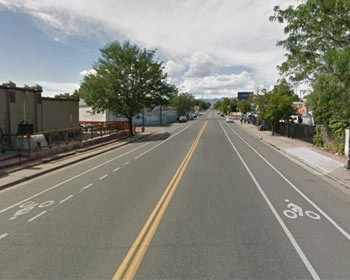

MPC Research Reports |
| Title: | Reassessing Child Pedestrian Mode Choice and Safety via Perceived Parental Risk |
| Authors: | Nick Ferenchak, Wesley E. Marshall, and Bruce Janson |
| Publication Date: | Mar 2019 |
| Report #: | MPC-19-375 |
| Project #: | MPC-557 |
| TRID #: | 01705843 |
| Keywords: | attitudes, built environment, children, cluster analysis, crash data, cyclists, geographic information systems, mode choice, parents, pedestrian safety, risk assessment, school trips, surveys, traffic safety |
 Traditional pedestrian and bicyclist safety analyses typically examine crashes, injuries, or fatalities. However, this reactive approach only accounts for the places where people are currently walking or biking and those that are doing so. Would a proactive approach – examining areas where pedestrian and bicyclist activity is being suppressed because of safety concerns – illuminate other previously neglected safety issues?
Traditional pedestrian and bicyclist safety analyses typically examine crashes, injuries, or fatalities. However, this reactive approach only accounts for the places where people are currently walking or biking and those that are doing so. Would a proactive approach – examining areas where pedestrian and bicyclist activity is being suppressed because of safety concerns – illuminate other previously neglected safety issues?
The goal of the first chapter is to compare results from reactive and proactive pedestrian and bicyclist safety analyses. To accomplish this, we focus on child pedestrians and bicyclists because of the structured characteristics of their travel behavior regarding trips to school. We complete a reactive crash cluster analysis and a proactive safety analysis that is based on trip suppression due to traffic safety concerns for Denver, CO. A parental perception survey informs the mode choice model we create for the proactive safety analysis. Findings suggest that reactive approaches identify downtown Denver and major corridors as unsafe, while the proactive analysis also identifies neighborhoods in west, east, and northeast Denver. Due to an absence of crashes, the majority of these areas would not normally be considered unsafe for pedestrians and bicyclists based on conventional reactive approaches. The fact that they are perceived as unsafe may be limiting usage and thereby limiting the number of crashes. In order to improve safety where children are currently walking and bicycling – as well as where they want to walk or bike – traditional analyses would benefit from augmentation by such a proactive safety approach.
The second chapter looks at the question: which populations are most impacted by traffic safety issues neglected by traditional crash analyses? Results suggest that negative impacts are borne disproportionately by low-income, low-education, Hispanic, and black neighborhoods. Proactive analysis results specifically identify perceived safety issues in neighborhoods in north and northeast Denver that were neglected by results from the reactive analyses. Findings suggest that the inequitable distribution of traffic safety issues identified in past crash-based literature – and confirmed in this work – is graver than a conventional reactive analysis would lead one to believe.
The last chapter presents a GIS tool intended to help cities better focus their Vision Zero efforts on the cities' most vulnerable users, kids.
Ferenchak, Nick, Wesley E. Marshall, and Bruce Janson. Reassessing Child Pedestrian Mode Choice and Safety via Perceived Parental Risk, MPC-19-375. North Dakota State University - Upper Great Plains Transportation Institute, Fargo: Mountain-Plains Consortium, 2019.